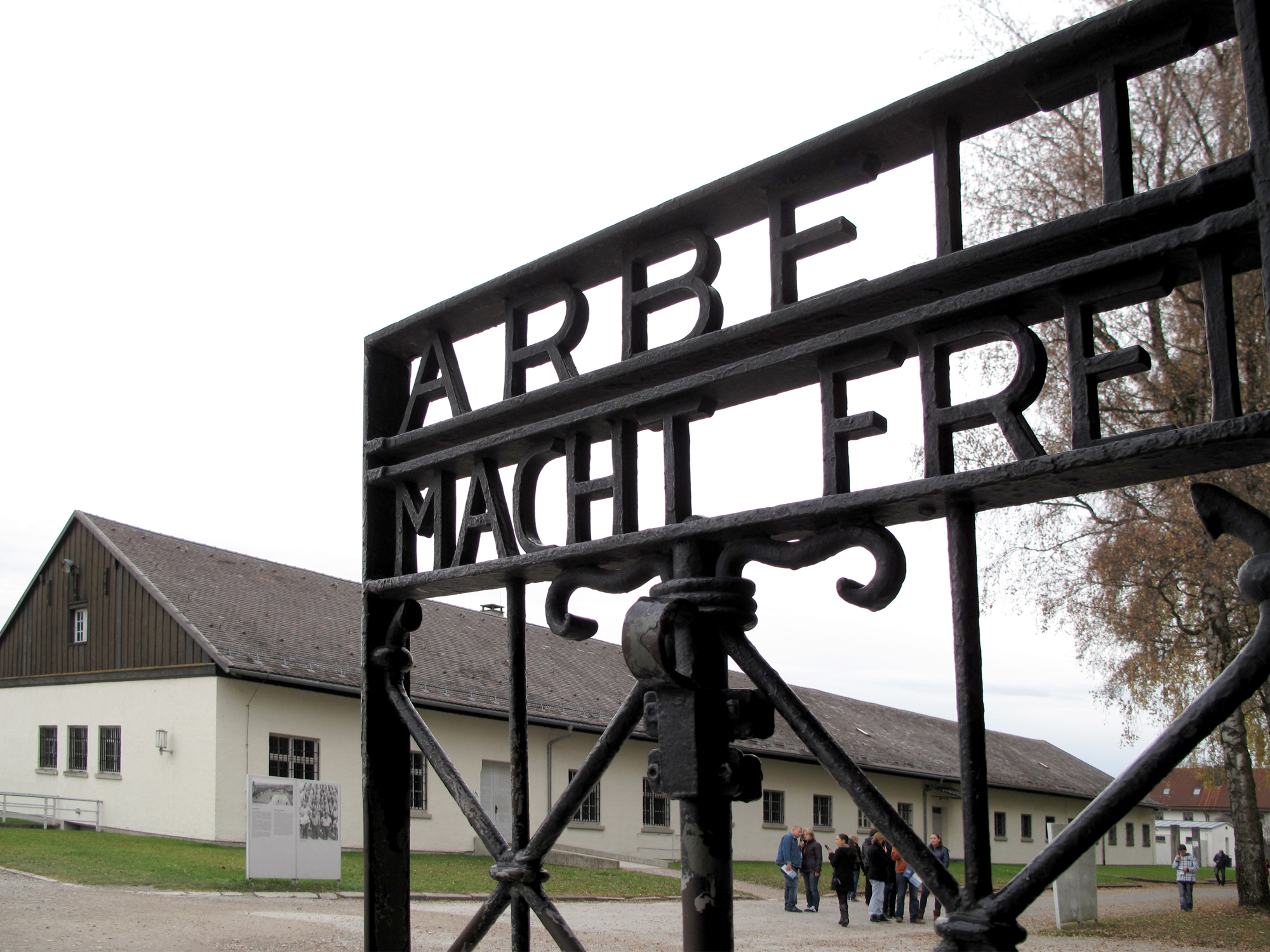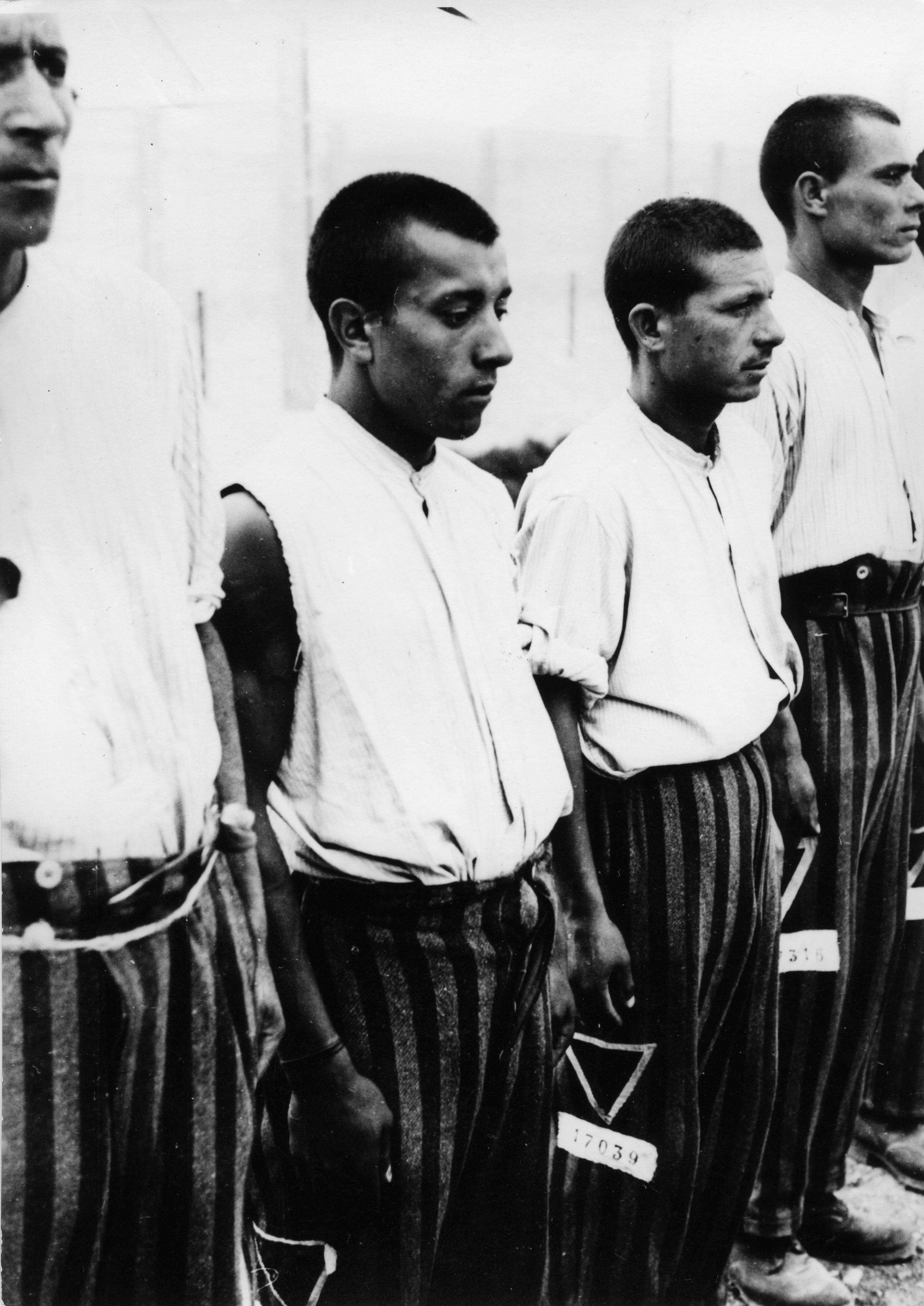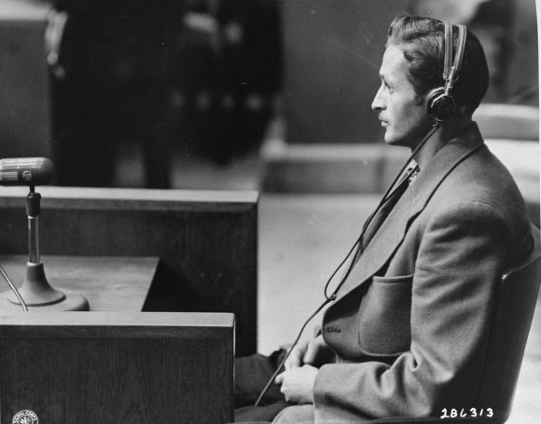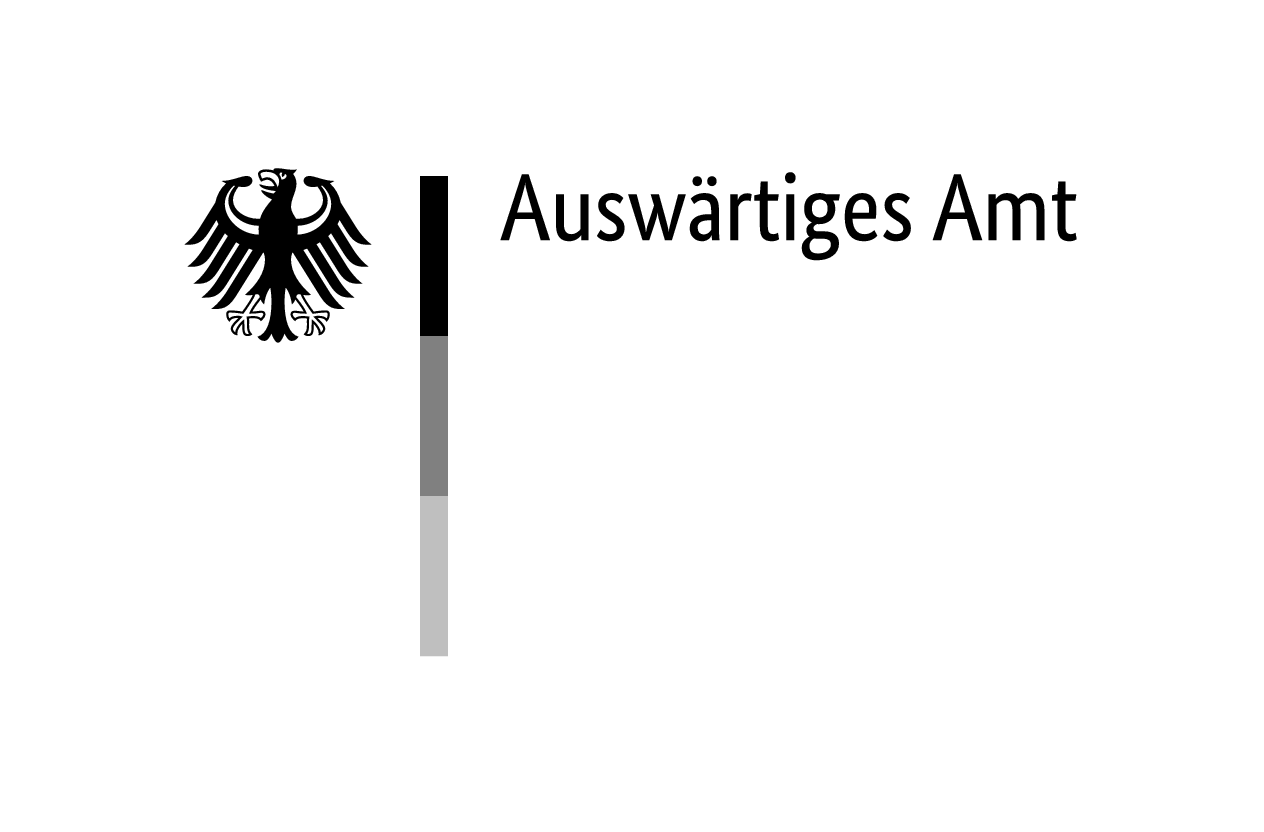The concentration camp, located around 30 kilometres from Munich, Germany, was the longest-running concentration camp in the German Reich. According to the latest findings, there were an estimated 2,400 to 2,900 Sinti and Roma of various nationalities among the inmates, the vast majority of whom were male.
Dachau Concentration Camp 1933–1945
Shortly after 30 January 1933, places of detention were established throughout the German Reich. The Dachau concentration camp, initially intended primarily for the imprisonment of male political prisoners, was set up on the site of a disused powder and ammunition factory. On 22 March 1933, the first transports arrived at the camp, which was initially under the control of the Bavarian state police, who were replaced by the SS from April 1933.
Even in the early stages, physical and psychological violence towards the prisoners was part of everyday life in the camp. As early as 12 April 1933, the first four Jewish prisoners were murdered by the SS under the pretext of an alleged escape attempt.

Eingangstor zum ehemaligen Lagerbereich des Konzentrationslagers Dachau, November 2010. Das am 22. März 1933 in der Nähe von München in Betrieb genommene Lager Dachau war das erste und am längsten existierende Konzentrationslager unter Verwaltung der SS (Schutzstaffel) im Deutschen Reich. Die Inschrift „Arbeit macht frei“ ist eine zynische Botschaft der SS-Verwaltung an die Häftlinge, die angeblich durch Arbeit umerzogen werden sollten. Tatsächlich wurden die Gefangenen physisch und psychisch gequält. Mehr als 200 000 Menschen waren insgesamt in dem Haupt- und den Nebenlagern inhaftiert, mehr als 40 000 starben bis zur Befreiung am 29. April 1945 an Gewaltverbrechen, Hunger oder Entkräftung.
Schätzungsweise 2 400 bis 2 900 Sinti:ze und Rom:nja verschiedener Nationalitäten befanden sich unter den Häftlingen, die übergroße Mehrheit von ihnen war männlich.
Fotograf: Nihad Nino Pušija
Nihad Nino Pušija
On 26 June 1933, Theodor Eicke (1892–1943) was appointed the second commandant of the camp and in October he introduced a ‘disciplinary and penal code’, which institutionalised the rule of the SS (Schutzstaffel) over the prisoners and was characterised by the arbitrary exercise of power and terror. With the permanent establishment of the concentration camp system in 1935, Dachau came to play a central role in the system, in which more and more people were imprisoned for racial, religious and social-racist reasons alongside political opponents. At the same time, the camp complex was further expanded.
During these years, the conditions in the camp became increasingly harsh. In 1938, following the November pogroms, more than 11,000 Jewish men were sent to Dachau, where they were held for weeks or even months. In the summer of the same year, a large group of Sinti and Roma were also sent to Dachau for the first time as part of ‘Aktion Arbeitsscheu Reich’. After the start of the war, the inmate population repeatedly changed in line with political or military developments.
The role of the so-called main camp in Dachau also evolved. From 1942, more and more satellite camps and external labour details were established, particularly in the south of Bavaria. In the two satellite camp complexes in Mühldorf and Kaufering, tens of thousands of prisoners were forced to build bunkers on construction sites for the relocation of the armaments industry, dying there in their thousands.
The main camp was liberated by American troops on 29 April 1945, after the SS had begun sending prisoners on so-called death marches to prevent their liberation. During the twelve years of the existence of Dachau concentration camp, more than 200,000 people were imprisoned there. At least 41,500 died of starvation, disease, torture, murder and the effects of the conditions in which they were held.
Sinti and Roma as an Inmate Group in Dachau
As with many other concentration camps, it is still not easy to determine the exact number of Sinti and Roma imprisoned in Dachau. In order to make an estimate, we take into account people who described themselves as Sinti or Roma, as well as people who were labelled as ‘Gypsies’ in National Socialist sources, but also people who can be identified as Sinti and Roma retrospectively through source research.
In the camp sources, references such as ‘Zig.’ or ‘Zigeuner’ are only found in significant numbers from the 1940s onwards. They were only briefly badged with a brown triangle in the summer of 1939, otherwise most Sinti and Roma in Dachau wore a black triangle on their clothing in accordance with the SS prisoner categories. In addition, relatively few survivors have spoken publicly about their time in Dachau, and this means that only a few sources are available.
The latest research assumes that a total of 2,400 to 2,900 Sinti and Roma were imprisoned in Dachau; of them 2,343 have been identified by name. The majority of these were men, though at least 370 women were sent to Dachau for a short time from the winter of 1944.
The Early Phase: 1933–1939
In the first five years of the camp’s existence, only a few Sinti and Roma appear in the sources as inmates. Although there are repeated references to the ‘beggar and Gypsy campaign’, as part of which the Bavarian authorities sent numerous people to Dachau, it is unclear at this stage whether there were actually any Sinti and Roma among them. The first Sinto known by name among the inmates was Bernhard Pabst (1912–1992) from Altenmuhr. Aged 22, he was registered on 16 May 1934 with the number 5860 as a protective custody prisoner, after he was involved in a brawl with local SA members.
The phase from June 1938 onwards is characterised by the mass incarceration of Sinti and Roma from Germany and Austria in Dachau in the context of the Reich-wide racially motivated ‘preventive fight against crime’ (‘Vorbeugende Verbrechensbekämpfung’). This first concerted action against Sinti and Roma in the German Reich was extremely vivid in the memories of survivors after 1945, as the example of the then ten-year-old Anton Winter (1928–unknown) shows: ‘The men were all gone, they had all been deported to Dachau concentration camp. That was 1938, I still know the date, on 17 June the Nazis arrested them, on 27 June they were sent to the concentration camp in Dachau.’1Winter, “Wir, die wir geblieben waren,” 237.
In total, there are several hundred people’s names in the Dachau admission books for that summer, all of which are labelled with the abbreviation ‘AZR’ (‘Arbeitszwang Reich’). In June 1938 alone, 856 people were registered. The chronicle of the Burgenland gendarmerie lists 232 Burgenland Roma sent to Dachau in June 1938, a figure which probably represents the majority of the 300 or so Sinti and Roma sent to Dachau in this context.
The 63-year-old Franz Horvath (1875–1939) was also among the inmates. Together with other Austrian Roma, he had written a letter of complaint to the Reich government on 12 May 1938, complaining about the treatment by the notorious Gauleiter and governor of Burgenland, the SA man Tobias Portschy (1905–1996), among other things.2Franz Horvath, “Daher habe ich mich kurz entschlossen, die hohe Reichsregierung anzurufen.” In RomArchive, 2017, www.romarchive.eu/de/collection/daher-habe-ich-mich-kurz-entschlossen-die-hohe-reichsregierung-anzurufen [accessed: 10/06/2025]. In Dachau, he was severely mistreated by the SS from the very beginning, placed in solitary confinement and finally transferred to Stadelheim prison. He died there on 22 October 1939, a good 16 months after being sent to Dachau.

Roma aus dem Burgenland im Konzentrationslager Dachau, Deutschland, Juli 1938. Anhand der Häftlingsnummern konnten Stefan Hodosy (2. von rechts) und Ignaz Horvath (rechts) aus St. Margarethen, Österreich, identifiziert werden. Sie waren unter den 232 Roma aus dem Burgenland, die am 25. Juni 1938 in das Lager eingeliefert und in Block 10 untergebracht worden waren. Stefan Hodosy (geb. 1911) wurde im Oktober 1941 nach Wien überstellt, weiteres ist nicht bekannt. Ignaz Horvath (geb. 1912) wurde im Konzentrationslager Mauthausen befreit.
Die Fotografie ist Teil einer Serie, die ein Münchner Fotograf im Sommer 1938 in Dachau anfertigte. Aus überlegener Perspektive vermittelt der Fotograf mit dieser vermutlich gestellten Szene die vermeintliche Zucht und Ordnung in nationalsozialistischen Konzentrationslagern. Für die Häftlinge war das Lagersystem jedoch von terroristischer Gewalt geprägt.
Fotograf: Friedrich Franz Bauer
Bundesarchiv, Bild 152-27-11A
Stefan Hodosy (also known as Hodosch) (1911–unknown) and Ignaz Horvath (1912–unknown) were among the prisoners admitted in June 1938. The two men from St. Margarethen in Burgenland can be recognised in the only photograph that was not taken as part of the identification procedure and shows Sinti and Roma in the Dachau concentration camp.
A year later, on 28 June 1939, at least 554 Sinti and Roma from Austria were sent to Dachau as part of a very specific action against ‘Gypsies’. On 5 June 1939, the Reich Criminal Police Office sent a letter to the Vienna Criminal Police Headquarters entitled ‘Preventive measures to combat the Gypsy menace in Burgenland’, ordering ‘[…] the work-shy and particularly asocial Gypsies or Gypsy Mischlinge of Burgenland to be taken into preventive custody by the police.’3Letter from the RKPA to the Vienna CID, 5 June 1939, reprinted in Steinmetz, Österreichs Zigeuner, 51. Often all male members of a family were sent to Dachau.
Sources on the living conditions of the Sinti and Roma imprisoned in Dachau are limited and the picture for the years 1938 and 1939 also remains very fragmentary. The summary of a conversation with the Austrian Sinto Rudolf Blach (1915–1997) is one of the few reports from Sinti or Roma about this time.4Archive of the Dachau Concentration Camp Memorial, A 1166, report on a conversation with Rudolf Blach on 11 June 1982.
He describes how the SS had mistreated them right from the moment of their arrival, going beyond the usual harassment. For example, the new prisoners’ clothes were burned and the Burgenland Sinti and Roma were thrown into the Würm river, which bordered the prison camp. In the following three months, the ‘Kapos’ (prisoner functionaries), especially those in the gravel pit detachments, pushed Sinti and Roma into the ice-cold water that collected there, whereupon they died of hypothermia.
Documents and interviews with members of other inmate groups confirm that Sinti and Roma were at the lower end of inmate society and that their chances of survival were even lower than for the inmates as a group. For example, Sinti and Roma were assigned to labour details with particularly harsh working conditions, such as the so-called plantation, where they had to carry out agricultural tasks on the heavy, wet moorland soil.
During a temporary evacuation of the camp from September 1939, the inmates were transferred to other camps. 570 Sinti and Roma were transferred to Buchenwald on 26 September 1939 and 143 to Mauthausen on 27 September 1939.5Arolsen Archives ITS DA, 1.1.6.1./9909812, notification of changes in Dachau dated 26 September 1939; ibid., 1.1.6.1/9913123, list for the transport from Dachau to Mauthausen on 27 September 1939. For information on the number of Sinti and Roma transferred to Buchenwald, see the research findings of Franziska Mendler at https://encyclopaedia-gsr.eu/lemma/buchenwald-en-1-0/. Over the next few years, at least 121 of them were registered again in Dachau.
Dachau Concentration Camp during the War: 1940–1945
With the beginning of the war, the persecution of Sinti and Roma intensified significantly. However, the Dachau concentration camp initially played a subordinate role during this phase. At least 368 Sinti and Roma who were admitted between 5 March 1940 and 2 August 1944 are currently known by name.
The reasons for deportation to Dachau during this phase were more diverse than before: it was mainly for individual reasons, such as violations of the ‘Immobilisation Decree’ (‘Festsetzungserlass’), arrests during raids directed against Sinti and Roma or so-called ‘workshy’ persons, unauthorised border crossings, charges of espionage or accusations of ‘Rassenschande’. The increasing expansion of the concentration camp system also meant that Sinti and Roma from other camps were transferred to Dachau.
At this time, Sinti and Roma were probably housed in certain rooms within the barracks that were intended for prisoners with a green or black triangle. A number of accounts of ‘Gypsies’ in Dachau by other inmates have survived from this phase. These reports offer an insight into the harsh living conditions in the camp, as well as the mistreatment of Sinti and Roma by the SS, but they tend to be interspersed with antigypsyist remarks.
Detailed reports by Sinti and Roma themselves are also the exception for this phase. One of the few reports comes from Leonard Blach (1920–unknown), a German Sinto, who talks, for example, about the labour detachments in which he was deployed: in munitions production, road construction work in the Schleißheim work detail and in a carpentry unit.6Archive of the Documentation and Cultural Centre of German Sinti and Roma (DokA), Gerd Kummet estate, interview with Leonard Blach (Munich-Daglfing) on 18 July 2002.
The 2,524 victims of ‘Aktion 14f13’ (Operation 14f13) who were transported from Dachau to the Hartheim killing centre in 1942 included Sinti and Roma. The research has not yet been done to determine their exact number. One of them was Karl ‘Wacker’ Horvath (1908–1942), who was taken to Hartheim on an ‘invalids transport’ on 28 November 1942 and murdered there on the same day.
The so-called seawater experiments, which were among the medical crimes committed in Dachau, took place in the final months of this phase. From August to September 1944, at least 55 people—most of them Sinti and Roma, including 40 men who had been transferred from Buchenwald specifically for this purpose on 7 August 1944—were used in a series of experiments commissioned by the Luftwaffe to make salt water drinkable.
Several of them, including the former boxer and later participant in the hunger strike at the Dachau concentration camp memorial, Jakob Bamberger (1913–1989), testified at post-war trials or reported on the experiments in their memoirs.

Der deutsche Sinto Ernst Mettbach (1920–1972) als Zeuge beim Nürnberger Ärzteprozess. Seine Aussage erfolgte am 21. Juni 1947 in Nürnberg, amerikanisch besetzte Zone Deutschlands. Verhandelt wurden u.a. die sogenannten Meerwasserversuche im Konzentrationslager Dachau. Die Versuche führte der Angeklagte Wilhelm Beiglböck (1905–1963) im Jahr 1944 an 40 Sinti und Roma durch, die dafür eigens aus dem Konzentrationslager Buchenwald nach Dachau überführt worden waren. Neben Mettbach sagte auch der Überlebende Karl Höllenreiner (1914–1984) aus.
Beiglböck wurde in zweiter Instanz zu zehn Jahren Haft verurteilt. 1951 befand er sich wieder auf freiem Fuß und praktizierte bis zu seinem Tod im Jahr 1963 als Arzt in Buxtehude.
Fotograf:in: unbekannt
USHMM, Photograph Number 43039, Public Domain
From the late summer of 1944, more and more inmates were sent to the Dachau camp complex because of the advance of the Red Army and the increased use of the satellite camps for forced labour. On the one hand, German and Austrian Sinti and Roma from other concentration camps, such as Natzweiler-Struthof, were sent to Dachau. On the other hand, Roma arrested in Hungary following the coup by the fascist Arrow Cross in November and December 1944 were deported to concentration camps on Reich territory for forced labour. At least 1,150 Hungarian Roma were registered in Dachau, including 361 women according to the surviving documents (such as transport lists or camp registry files).
However, these Hungarian Roma only stayed in Dachau for a few days before they were transferred to Ravensbrück and Bergen-Belsen. Of the men, 285 remained in the Dachau camp system (they were mainly in the main camp and the Allach and Munich-Riem satellite camps), and at least 160 of thom did not survive the liberation.
Istavan Kolompar (1869–1944) was among the first to die. He and his family lived near Bicsérd, a small town in the south of Hungary. At the beginning of November 1944, three generations of the family were arrested by the police and initially taken to Csillag. Istavan, the 75-year-old grandfather of the family, arrived at Dachau on 18 November 1944, where he died on 14 December 1944.
József Balogh (1928–unknown), a Slovakian Roma who arrived at Dachau on 21 December 1944, aged just 16, described in an interview scenes of everyday terror towards the inmates, such as standing for roll call for hours on end. The history of the Hungarian Roma in Dachau represents another gap in research.
On 29 April 1945, the main camp of the Dachau concentration camp was liberated by American troops. At least 19 Sinti and Roma died in the following weeks as a result of their imprisonment, and a total of 241 Sinti and Roma are registered as having died in Dachau. It is not known how many of the Sinti and Roma who were inmates of Dachau between 1933 and 1945 were murdered in other camps.
Post-War History and Memory
There is still research to be done on the importance attached to the Sinti and Roma victim group in the post-war period and the early phase of the history of the Dachau Memorial. In the first permanent exhibition after the Dachau Concentration Camp Memorial was established in 1965, Sinti and Roma were only mentioned twice, and they were also named in a list in the accompanying documentary film.
In the new exhibition which was created at the end of the 1990s and which can still be viewed today, they were given much more attention, but it is clear that at that time there was still very little basic research on Sinti and Roma in Dachau. Accordingly, the account of what happened in the camp is filled out with material on the wider context of Nazi persecution, such as information on the ‘Racial Hygiene Research Unit’.
There are also monuments commemorating the Sinti and Roma inmates in two places on the site. At the International Memorial, inaugurated in 1968, there is an installation with different coloured triangles, including a brown triangle. The brown triangle was deliberately added by the International Prisoners’ Committee after the triangles for so-called ‘asocials’ (black), ‘professional criminals’ (green) and homosexuals (pink) had been removed from the design at the request of the Committee.
A plaque donated in 1980 by the singer-songwriter duo ‘Duo Z’—Rudko Kawczynski (born 1954) and Tornado Rosenberg (born in the mid-1950s)—also hangs in the memorial room at the end of the permanent exhibition.
Hunger Strike in 1980 and Sanctuary in 1993
This plaque was brought to the Dachau concentration camp memorial centre in the course of a hunger strike. The strike, which is central to the history of the civil rights movement of the Sinti and Roma in Germany, followed on from previous actions such as the large rally at the Bergen-Belsen memorial site the year before. Activists from the German Sinti Association and the Society for Threatened Peoples, which had been supporting the movement for some time, wanted to use the action to draw attention to the files from the Nazi era that were still in circulation and the continued practice of discrimination by the police and authorities after 1945.
Lasting from 4 to 11 April 1980, the hunger strike attracted a great deal of attention with widespread coverage in the national and international press and several television reports, including the national newscast ‘Tagesschau’. A total of twelve Sinti, among them the later chairman of the Central Council of German Sinti and Roma, Romani Rose (born 1946), and the Munich social worker Uta Horstmann (born 1950), took an active part in the hunger strike in the Protestant Church of Reconciliation on the grounds of the memorial.
Particularly impressive was the participation of four survivors, three of whom wore their concentration camp uniforms at the start of the hunger strike: Jakob Bamberger, Ranco Brantner (1931–1996), Hans Braun (1923–1999) and Franz Wirbel (1922–1986). The two musicians from Duo Z also took part for the first few days. The hunger strike finally ended with a compromise. The three parliamentary groups in the state parliament at the time declared that the Bavarian Landfahrerordnung of 1953 had had a discriminatory effect on Sinti and Roma. However, the greatest political success of the young civil rights movement was the broad media coverage that the action received at a historic site such as Dachau.
In 1993, the memorial became the site of the struggle for the right to stay for Roma who had fled to Germany as a result of the civil war in the former Yugoslavia. From 16 May 1993, 40 Roma refugees from Macedonia, Croatia, Serbia, Romania and Bulgaria initially came to Dachau and, under the leadership of Jasar Demirov (born unknown), the then chairman of the Roma Union of Southern Germany, asked for sanctuary in the Church of Reconciliation. By the beginning of June, 150 people had already been accommodated in tents in the grounds of the Catholic Chapel of the Agony of Christ and the Carmel of the Holy Blood.
After the conflict between the memorial and the Protestant church authorities on the one hand and the state government on the other continued to escalate, the ‘place of sanctuary’ was on the verge of being forcibly evacuated by the police at the end of June. On 5 July 1993, the Ministry of Culture and the churches called on the Roma present in Dachau to leave the site. On 7 July, shortly before midnight, the last Roma left the memorial site in buses and a large number of them were taken to Strasbourg.
This marked the end of the ‘place of sanctuary’ after 54 days, without the action on site and the numerous demonstrations and expressions of solidarity having brought about any change on a small scale, let alone in the German government’s asylum policy towards Roma.
Concentration Camp Memorial
The history of the Sinti and Roma imprisoned in Dachau has only played a significant role in the educational and commemorative work at the site of the former concentration camp since the early 2010s. Since then, the Dachau Concentration Camp Memorial has regularly offered themed tours, and the Max Mannheimer Study Centre, which is also located in Dachau, integrates Sinti and Roma inmate biographies (for example Jakob Bamberger or Karl ‘Wacker’ Horvath) as well as a separate unit on the history of the inmate group into its seminars.
The Dachau Church of Reconciliation regularly organises events with survivors, relatives or other people involved in these themes on the history of Sinti and Roma or on current issues. Representatives of Sinti and Roma organisations have been present at memorial events, such as the death march commemoration or the liberation ceremony, for many years.




